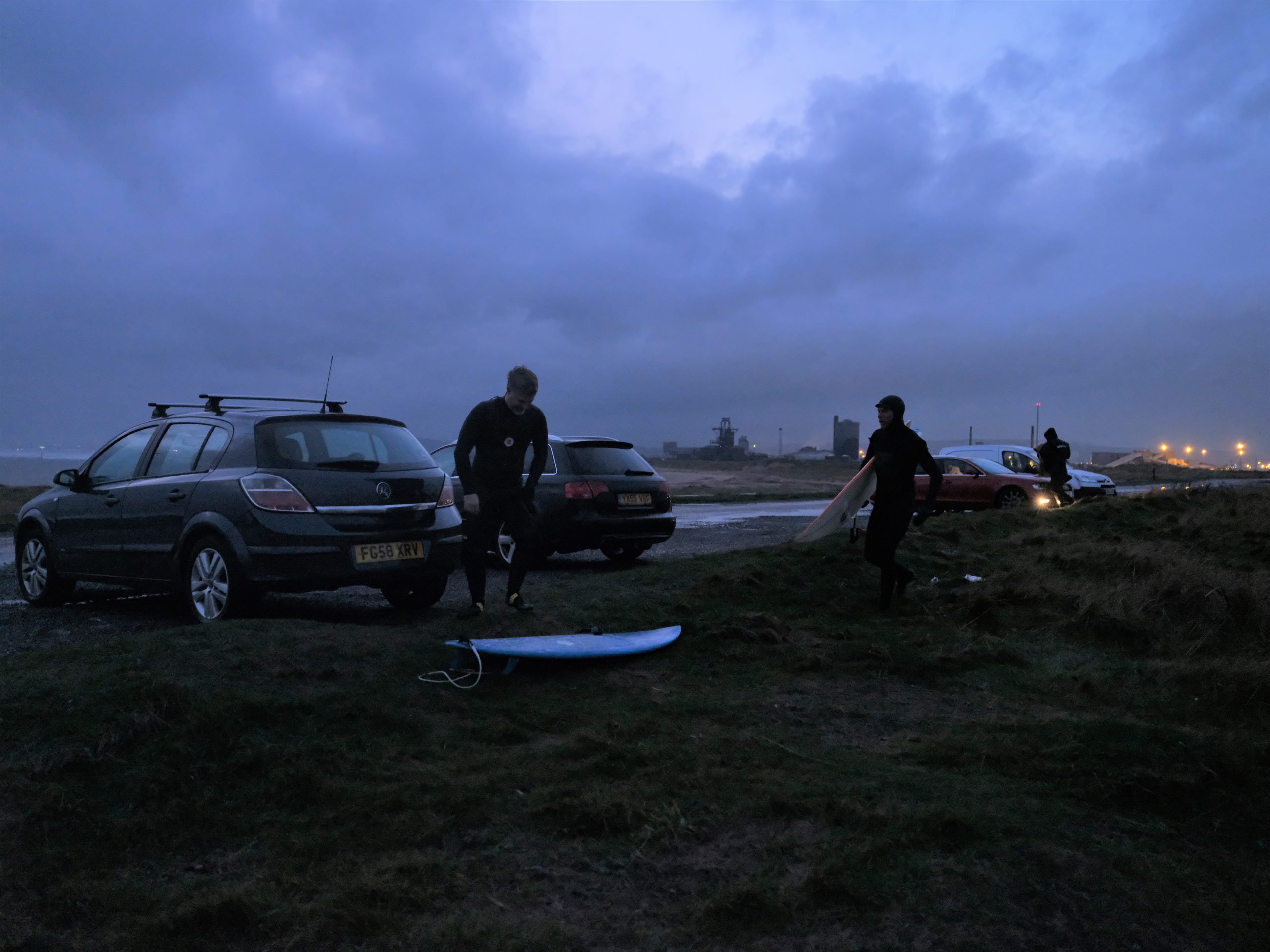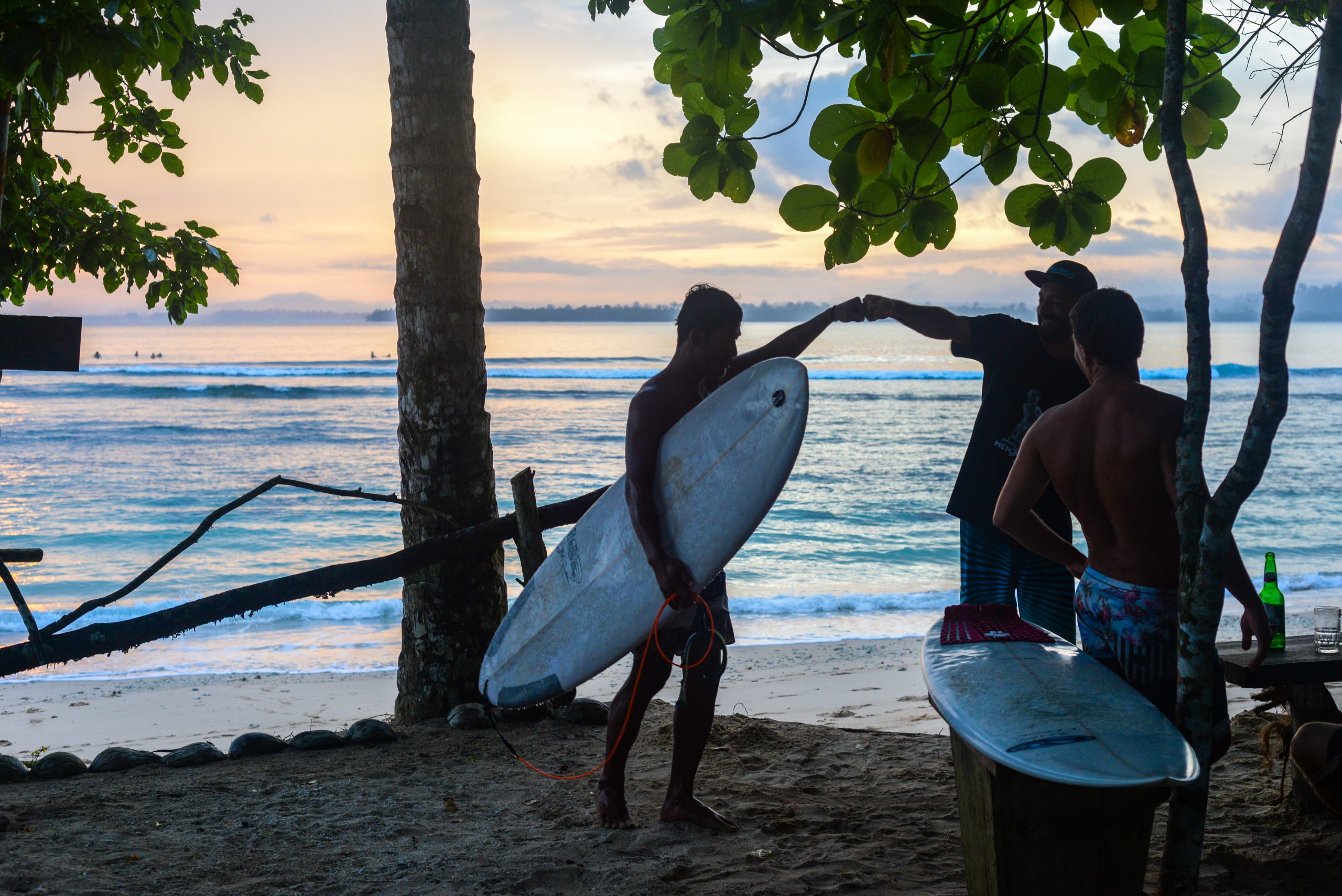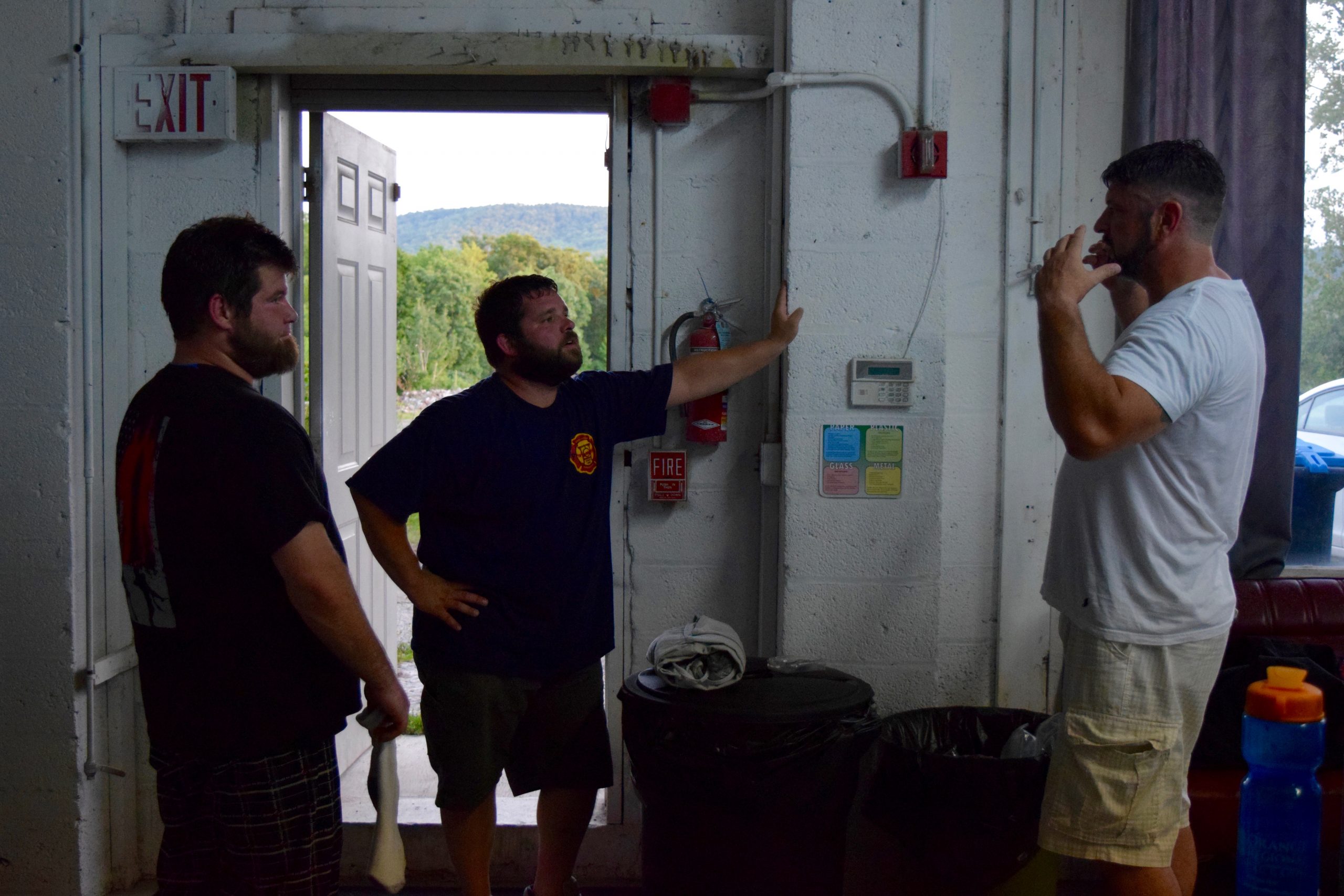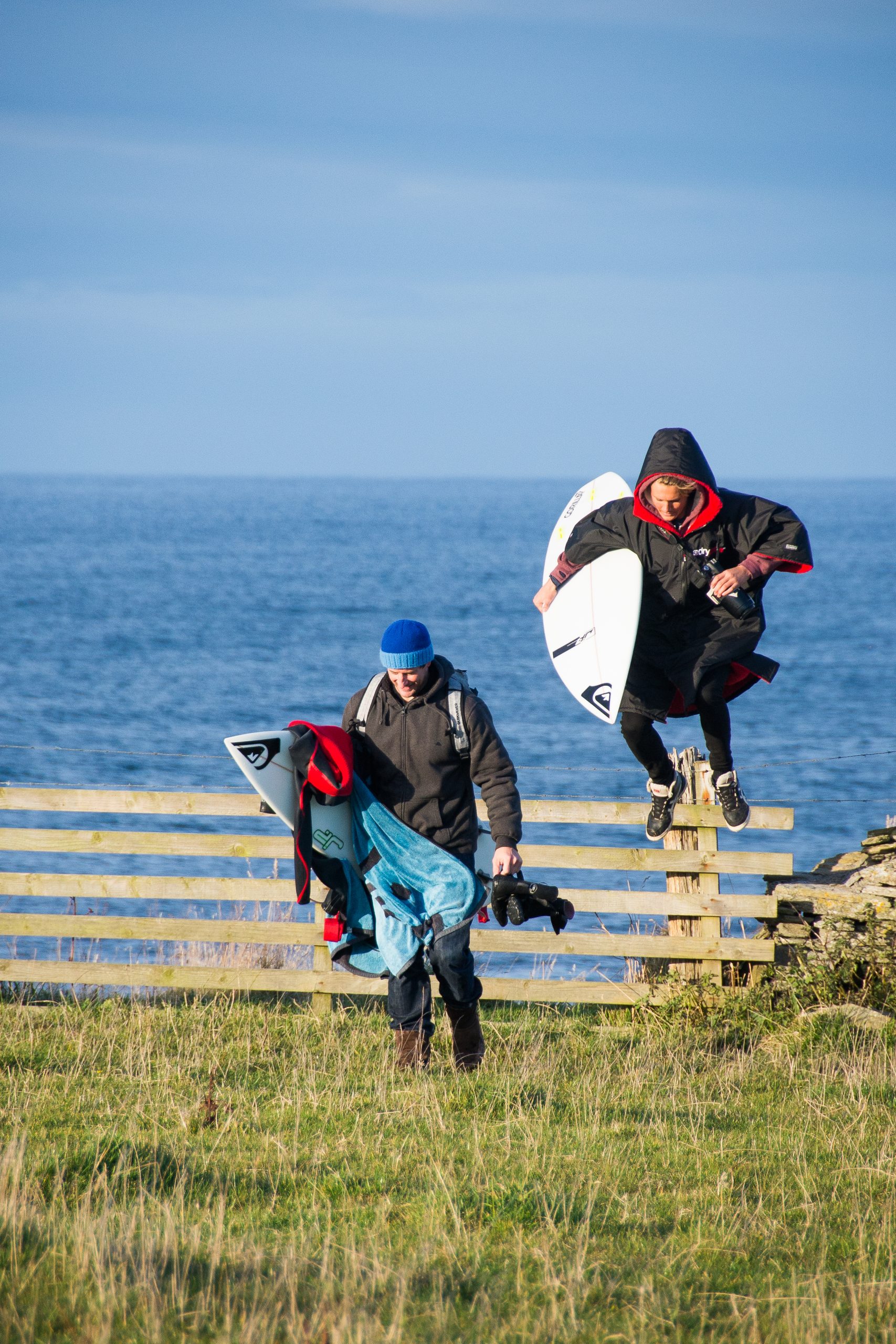Intimacy on the Mats and in the Surf
Matt and Chris
The bell rang out, signaling the end of the final round of sparring—an exhausting combination of striking and grappling. Matt and Chris collapsed simultaneously on the mats. Each soaked in a mix of their two sweats. They made an odd pair. Matt, was a young hip urbanite with a trendy haircut and brand-name training gear, who recently returned from taking part in the women’s march. Chris, a self-declared “country boy libertarian,” was sporting a high buzzcut and a large tattoo of Jesus on the cross that was now visible through his soaked, thin white t-shirt.
As they engaged in light stretching while massaging their sore body parts, Chris picked up the downtrodden reflections he had begun prior to sparring. Going deeper into his frustrations with work, Chris told Matt: “none of them [his employers and co-workers] care about me. They’d like me better if I were actually a machine.” Matt put his hand on Chris’s shoulder, “We care about you…and you are a machine.” The two made eye-contact, smiled, laughed, and continued to converse about the abundance of superficial friendships and the struggle to find meaningful connections outside the MMA gym.
David
Today, ‘the boys’ have been surfing locally. As they sit and bob in the sea, the conversation moves to how David has been depressed since the factory shut down. It’s become a struggle for him and his family. When eye contact with David is lost, others notice his head goes down. They feel vulnerable, too; they are of the same community. There is a sensitivity fostered by how the emotional lives of the men spill all over each other. A hand reaches over to rustle his hair. A lowered voice reassures him that they’ll all pitch in and go grocery shopping on the way home. The rent will be paid. A wave comes, David catches it, blocking a visiting surfer. Local surfers get priority to waves. The boys hoot and holler at David, adding to his enjoyment of the wave. Empathy and care are directed toward some bodies rather than others. They do not flow freely.
Men and Sport Communities
Combat sports and surfing have long caught the public’s imagination. Whether the more celebratory exploration found in best-selling and critically acclaimed works of literature, art, and film—including Joyce Carol Oates’ On Boxing, Chuck Palahniuk and David Fincher’s Fight Club, and the cult classic Point Break—or the more critical interrogations found in academic journals, the two practices continue as bastions of “traditional” masculinity. There are clear differences between men exchanging punches, bending joints, and rolling on sweat-covered mats, and sun-kissed bodies traveling the coast in search of the perfect wave. Both communities, however, rely on hierarchical codes of etiquette and belonging enforced and enacted through physicality and violence.
When discussing our respective studies of mixed martial arts (MMA) and surfing, we were struck by another similarity: the messy and intense emotional lives of the men involved in each sport. Kyle has spent over five-years taking hits in MMA gyms in the Midwest of the United States, and Clifton has twenty years of experience examining surfing communities around the world. Each author offers insight into the how men in both sports “do” modern masculinity.
Contrary to our initial assumptions, practitioners of both surfing and MMA regularly move beyond the affirmations of the traditionally celebrated masculine traits of strength and stoicism, also surrendering to a vulnerability and emotional intimacy. In fact, emotionally intimate connections serve as a central allure of both practices—a finding that requires us to seek out an alternative to the dominant sociological approaches to masculinity.
In this article, we argue for the importance of a sociological approach that explores masculinity as a process and does not pre-determine what may happen as masculinity happens in real time. This processual approach involves detailing reification of dominant practices and values, but also, being more attuned to how these performances are never settled. Focus also shifts to the momentary ruptures along the way that can potentially undermine those dominant practices and values or even replace them with alternatives, sometimes more ‘care-full’ but also sometimes more ‘harm-full.’
Focus also shifts to the momentary ruptures along the way that can potentially undermine those dominant practices and values or even replace them with alternatives, sometimes more ‘care-full’ but also sometimes more ‘harm-full.’

Models of Masculinity: Hegemonic Masculinity
Sociologists have had a lot to say over time about men’s attraction to sport and the dangers associated with it. Most influential has been the work of Michael Messner and Raewyn Connell. Messner has explored how sport offers a socially accepted site for boys to learn to be men and for those men to differentiate themselves from women through the unabashed celebration of traditional tropes of toughness and stoicism. Connell’s concept of “hegemonic masculinity” is used to examine sport’s role in the reproduction and reclamation of particular unethical and harmful iterations of masculinity, e.g., a reification of strength and violence.
This theory is predicated on the insight that masculinity comes in multiple forms, with the hegemonic ideal having higher concentrations of the qualities that subordinate and marginalize other versions (as well as women and other sex-gender affiliations).
There is no denying that sports such as MMA and surfing validate and reproduce many hegemonic—sometimes labeled “toxic”—masculine values and practices, including violence, sexism, misogyny, and homophobia. We witnessed firsthand how this form of social conditioning can be further exaggerated in settings occupied almost exclusively by men. As cultural theorist Eve Kosofsky Sedgwick argues, such “homosociality” fundamentally involves a reproduction of heteronormativity by orientating any relationship and desire between men through a third “object” or activity. Shared physical excitement was re-directed through discussions of the effectiveness of a fight technique or thoughts on a wave to be ridden. Even more overtly, surfers and fighters will offer detailed tales of the pursuit of women as they prepare to engage in their sport of choice. Thus, any potential for erotic interpretation of a male-to-male relationship is interrupted and simultaneously, homosexual desire is demonized. Through this process, any overt intimacy is managed and policed.
We also found ample evidence of the beach and gym operating as places for men to (re)claim and reproduce hegemonic (toxic) masculinity. As Matt and Chris, the two men in the introductory vignette, learn to fight, they also share “what if” stories of brawls in bars, in urban environments, and during travels abroad that entertain and draw in a crowd. Proper masculinity is defined through affirmation that men should learn these physical skills to counter the perceived loss of confident, independent men in wider society.
Similarly, the beachside carpark is turned into an exclusionary space as men gather and change into and out of wetsuits. They laugh and tease each other as they do so, brazen in their nudity. However, no lingering look at another man’s body is permitted. Although women surfers using this public “locker room” will often experience the men’s uncomfortable sexual gaze.
Models of Masculinity: Inclusive Masculinity
More recently, a second model of masculinity has emerged that challenges the idea that homosocial sporting arrangements inherently reproduce hegemonic hierarchies and reject alternative forms of behavior. Most notably, Eric Anderson has argued that there has been an increase in “inclusive masculinity” in some sports settings whereby multiple masculinities harmoniously co-exist. Anderson argues that increasingly young men willingly express intimacy with each other with little concern about opposing homosexuality to validate their own heterosexuality. While this article is based on a type of inclusivity built on vulnerability and tenderness, we found little acceptance of the celebratory progress towards inclusion that Anderson writes of. Even when emotions that may be interpreted as the acceptance of eroticism between participants are expressed, these emotions tend to be mobilized as a mechanism for exclusion. Momentary transgression of such norms may occur but are permissible by the group only if one quickly returns to confirm their adherence to them. Transgression often proceeds through humor, which serves as a popular way to block any erotic potential from “settling in.” Further, while both researchers observed participants voice support for gay rights and marriage, and even witnessed direct callouts of homophobia in the respective communities, the unwritten and unmentioned codes remain entrenched. These rules, when broken and not reinstated, will lead to rejection, othering, and even violence.
Models of Masculinity: Hybrid (and Beyond)
Our research offers some support for the “hybrid” masculinity model as recently formulated by Tristan Bridges and C. J. Pascoe. This third way forward emphasizes how multiple masculinities can be performed by the same individual depending on the circumstance; there exists contextual flexibility to embody less dominant variations. While this sounds like real progress, let’s not celebrate yet. Even though there is movement, it is men who have the most of what Raewyn Connell (recall model one) calls “patriarchal privilege.” Different men have differing access to resources and “permissions” to embody and even play with alternative variations that could be read as taboo. Those positioned most closely to hegemonic traits (e.g., being white, affluent, heteronormative, identified as male at birth) get more choice and flexibility. Such choice and flexibility remain more restricted for others.
We have found value in paying attention to patriarchal privileges in our sport communities. The overtly traditional masculine aesthetic of surfing and fighting accrue the “gender capital,” to use Bridges term, allowing softer performances like group discussions of fashion choices, grooming techniques, body care, personal relationships, and self-doubt. However, when paying attention to the emotional and physical connections on the mats and in the surf, we observed unexpected connections, movement, and flexibility. We paused, caught off-guard. There was a bit more to the story.
Ruptures and Style
Our respective ethnographies pushed us to go further into how shared moments of intensity were creating intimate and sensual connections that can result in toxic values and practices, and progressive beliefs and effects. We witnessed the dynamic, messy realities that resisted any straightforward analytical determination as hegemonic or inclusive. A language of models, varieties, and types simply became too structural to register the ongoing fluctuations and unexpected outcomes that occurred. Instead, we worked toward articulating experiences of masculinity in a way that could better demonstrate the immense ongoing variety of inter and intra-actions that take place as masculinity is done.
We began to refer to masculinity through a language of style to connote how arrangements are always in process, involving an open-ended adaptation to contingent situations and contexts. We are not confronted with perfectly set patterns because material, spatial, economic, cultural, and social elements are always coming together and breaking apart. Masculinity for these men involves a highly tuned sensitivity to this movement. In training alongside and engaging in dialogue with the fighters and surfers, they drew attention to how often what they did was guided by not simply the cognitive, but the felt. They would experience a rush of blood to the face or the hair rising on the back of the neck. As they became conscious of this, they employed social and cultural discourses to sort out and qualify what they were feeling—does this flushing of the face equate to embarrassment, shame, anger, disgust? How then to behave? It is not possible to follow a script that would imply any straightforward repetition. Rather, style is a modulation in situ, infused with a necessary creativity. We believe that understanding masculinity as a style has political potential as it emphasizes the felt ongoing production of difference as well as the potential to do things differently.
Style has political potential as it emphasizes the felt ongoing production of difference as well as the potential to do things differently.
This is not to say there is no larger social organization of masculinity. However, we understand masculinity as a process of blocking, containing, and closing off creative possibilities. It is the continuity of certain practices and values, albeit adapted to the current circumstance. The dynamism that our participants experienced as they were caught up in contextual and contingent moments shifted our attention away from trying to identify hegemonic masculinity or other typologies. Instead, we were guided by the codes of the wave or the fight; both are fluid, transformable, and always on the edge of collapse. The effect was an undermining of any certainty as to how masculinity should or should not be done, what practices would or should mean in different contexts, and indeed where things would go next. Rather than ask what good or bad masculinity is, or what type of masculinity is this (or not), new questions now came to the forefront: What blocks possibilities? What enhances potential? What increases the power to act and connect? What diminishes, contains, or restrains?
If a boy is hanging out after displaying skill to a cohort of working-class surfers whom he admires, he may get a pat on the back or catch their approving eye. This moment of intimacy charges his nervous system. His eyes light up, face flushes, and he gets a shiver down his spine. The touch can make the boy feel like he just got a knighthood. He qualifies the affective interaction via his social context as the emotion of joy (or in surfing terms: stoke). However, this changes as he steps away from this cohort for a moment and crosses paths with tourists who might marginalize and even denigrate his social class. The denigration also induces a flush of the face and a tingling of the spine. This time they are deciphered according to social learning as shame. In turn, that shame may transform into an “irrational” anger and hardened exterior.
Our sensual life is never entirely under our control. Many contextual conditions play out, and the boy must ride the waves, adapting to the shifting conditions as he does so. No two waves (situations) are the same, and each one is itself fluid. Masculinity as style is registered on and fueled by an affective and emotional spectrum.
In the gym, a training partner provides help by placing the dental guard in a mouth or strapping a groin protecting belt around the waist after noticing the fumbling attempts from the gloved hands of someone about to spar. The caring touches briefly interrupt the jittery isolation of self-doubt—the attempt to project the “appropriate” stoic confidence returns after a quick acknowledging laugh. Post-sparring the openings and connections are more apparent as the men exchange hugs, smiles plastered on their bloodied faces, words pouring out before mouth guard is removed or sentences fully formulated. The shared intensity temporarily breaks open the cold façade of masculinity, allowing exploratory dialogue at both the felt and verbal level.
Studying the Sidelines
So what are the takeaways from our respective ethnographies and our shift in theoretical orientation? The first is a methodological lesson. Popular depictions and academic studies of men, masculinity, and sport tend to focus on the moments of peak involvement and intensity of participation—the action. There is a tendency to marginalize the mundane: The hours of driving, carrying gear along the beach, suiting up, watching the sea, and paddling out to mostly bob up and down staring at the horizon before catching a wave; the MMA hobbyist spending hours drilling a particular submission chain, holding pads while a partner works to perfect a striking combination, and entertaining with stories while recovering enough to go another round.
We found that in the atmospheres of the banal and mundane, the emotional life of men leads to much slippage when it comes to how one does or does not do masculinity, as well as what is defined as “acceptable” or not. It is during such “downtime”—the sitting on the mats post-fight, covered in the salty residue of shared sweat, or the staring at the horizon post-surf, covered in the salty residue of shared ocean—that participants explore the openings brought by exchanging blows and submissions or through sharing the fun of catching a wave. There is a certain vulnerability in these fleeting moments as the men attempt to make sense of what just happened, ask difficult questions, and share issues that previously were kept private. These are the moments of intimacy and connection that participants refer to when stating that they know their fellow surfers and fighters in a way they do not know others.
Let us again consider the fighters Matt and Chris. Identifying their “type” of masculinity would be markedly different, with only a slight shift in attention.
Ten-minutes prior to the opening vignette, Chris responded to receiving a clean punch from Matt by moving his lips into a formation somewhere between snarl and smile. Shaking his head to indicate he wasn’t hurt, and then pouring on a barrage of punches until Chris, trapped against the mat-covered wall, had no choice but to clinch and hold tight until the timer saved him.
Much scholarly analysis would emphasize the hardened shell the men had constructed to maximize their ability to absorb, deny, and inflict pain in an apparently violent manner. Not to mention, just slightly before the aggressive sparring, the two reveled in the re-telling of a gym member’s late-night drunken conflict at a local diner, effectively establishing the importance of men always being ready for a fight. By the end of the training session, the mats facilitated comfort and care as the two shared a restful moment and reassured each other of their bond—a connection lost through a methodological insistence on the moments of high intensity.
To be fair, in our own experience, it is a lot of fun (and more than a bit self-congratulatory) to detail masterfully overcoming opponents and waves. However, in marginalizing the mundane, we relegate a vast constellation of experiences of masculinity to the “sidelines” and offer an incomplete documentation of men’s lives in and through sport. In particular, the narrow focus effectively gets in the way of attuning to the movement and creativity that could ignite alternative doings of masculinity, which leads to our final point.
Fragile Possibilities
Masculinity is fragile. Although the statement is often used pejoratively, especially in hashtag form (#masculinitysofragile), we suggest this is no bad thing but rather something to celebrate as a point of intervention. It is vulnerability—an openness and attunement to the emotional life of men—that will offer fresh insights into how masculinity is stylish. There is always the potential for the new or out-of-the-ordinary to occur, even as many of these potentials are effectively rounded up, captured, and blocked. Our research demanded from us, and calls for others to avoid beginning with and ending with the premise that men are simply alienated from their emotional selves. In fact, they are highly sensitive to movement, and this underlines masculinity as style. That is, an ongoing creative adaptation to instability, being incomplete, and change.
This is not to say that any political potential or progress will necessarily be realized (often the opposite is true!), but there is certainly hope. We found that by working harder to highlight the “care-full” negotiations in these at times toxic sites, research participants would notice and let their guard down. The result was some participants engaging in self-introspection that led to discussions of other possibilities for understanding and doing masculinity, supported by a reassurance that there is already evidence of them being capable of such.
We argue that approaching masculinity as style and process can reveal new avenues of exploration that are hidden by dominant models of scholarship. It is by laying bare the everyday dynamism of masculinity that we can undermine understandings of, the organizing of, and assumptions that block change.
Kyle Green is an Assistant Professor of Sociology at The College at Brockport, State University of New York and Clifton Evers is a lecturer in media and cultural studies at Newcastle University.





